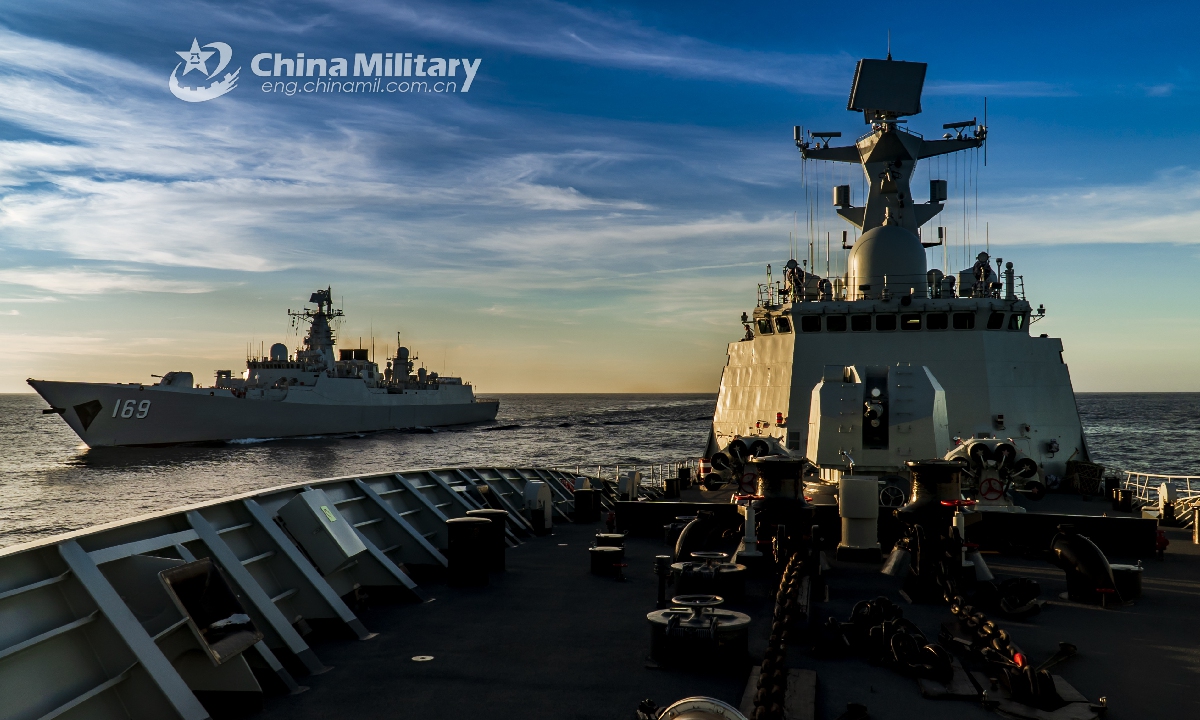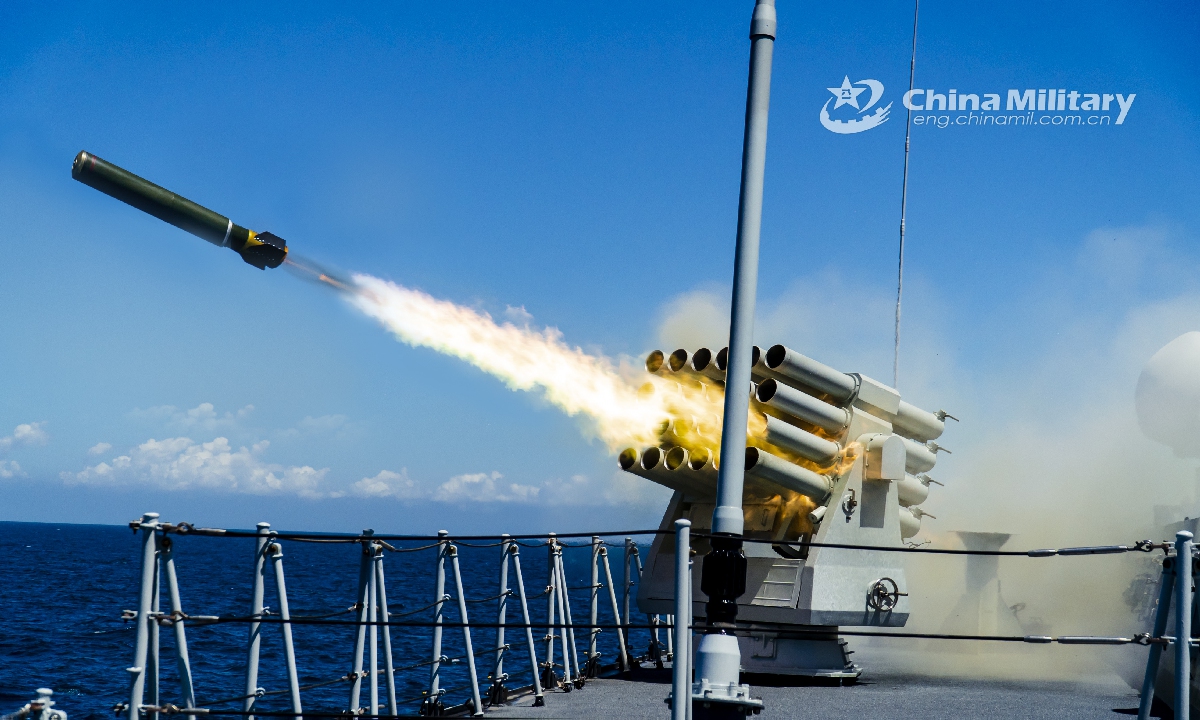Rare US dual aircraft carrier drills in South China Sea ‘a show’ for allies
By Liu Xuanzun Source:Global Times Published: 2020/7/5 19:23:40 Last Updated: 2020/7/5 21:43:40
PLA exercises in same time frame, ready to defend against aggression

The guided-missile frigate Hengyang (Hull 568) and the guided-missile destroyer Wuhan (Hull 169) attached to a destroyer flotilla with the navy under the PLA Southern Theater Command steam alongside with each other during a maritime maneuver operation in waters of the South China Sea on June 18, 2020. (eng.chinnmil.com.cn/Photo by Li Wei)
At a time when relations between China and the US are further deteriorating over a series of topics including trade, the COVID-19 pandemic, Taiwan and Hong Kong, the US has deployed two aircraft carriers and other warships to the South China Sea for its largest-scale exercises in the region in years, which also coincided with Chinese military drills taking place in the same area and time frame.
The two US aircraft carrier battle groups are nothing more than paper tigers on China's doorsteps, as the region is fully within the grasp of People's Liberation Army (PLA) with specially made weapons that can destroy aircraft carrier, and US drills are a mere show to make up for its loss of face regarding epidemic control, and indicated it knows it has lost its Hong Kong card following China's national security legislation, forcing it to shift focus to the South China Sea and Taiwan to contain China, analysts said on Sunday.
The PLA is conducting intensive drills and has recently tested a new naval missile in the Bohai Sea, and is ready to defend against aggression, reports said.
The USS Ronald Reagan and USS Nimitz aircraft carriers are holding large-scale exercises in the South China Sea together with four other warships starting Saturday, CNN reported on Saturday.
Since the South China Sea arbitration in 2016, the US has not conducted joint operations featuring two carriers near the South China Sea. According to Zhengzhijian, a WeChat public account run by Beijing Youth Daily, the last time two US carriers conducted exercises in the South China Sea was in 2014.
Song Zhongping, a Chinese military expert and TV commentator, told the Global Times on Sunday that the US move aimed at enhancing its military presence in the West Pacific, is designed to show off that its hegemony in the region is unshakable, and boost confidence for its regional allies.
Beijing-based naval expert Li Jie told the Global Times that the US is pushing its aircraft carriers onto the frontlines to show its military power remains the strongest in the world despite having been hit hard by the COVID-19 epidemic. It was once left with no aircraft carrier to use in the Asia Pacific region for more than two months.
The US is also attempting to deter PLA movements in the South China Sea and on the Taiwan question, Song said.
The US has been playing its Hong Kong card to contain China's development for the past years, but after the national security law for Hong Kong came into effect on Tuesday, it's well aware that it has lost this card, so the US has shifted its focus to the South China Sea and Taiwan, in which military might plays an important role, analysts said.

The guided-missile frigate Hengyang (Hull 568) attached to a destroyer flotilla with the navy under the PLA Southern Theater Command fires chaff rounds from the decoy launching system to deploy electromagnetic smoke during a maritime live-fire training exercise in waters of the South China Sea on June 18, 2020. (eng.chinnmil.com.cn/Photo by Li Wei)
Chinese drills and missile tests
Not only are US exercises with two aircraft carriers in the South China Sea rare, it's also rare that China is also holding drills in the South China Sea in the same time frame.
According to a notice released by China's Maritime Safety Administration, the Chinese drills, also in the South China Sea, near the Xisha Islands, run from Wednesday to Sunday.
In separate operations, the PLA has been conducting intensive drills in the South China Sea, East China Sea, and Yellow Sea recently, China Central Television (CCTV) reported on Saturday. Advanced warships including Type 052D guided missile destroyers and Type 054A guided missile frigates were involved.
In the Bohai Sea, the PLA Navy recently test launched an undisclosed new type of missile, CCTV reported on Saturday. The report did not elaborate on the missile's purpose, but footage suggests it can be launched from a warship.
Three US aircraft carriers have been conducting exercises in the Philippine Sea just outside the South China Sea since June, which has stirred up regional tensions, Chinese military observers said, noting that Chinese drills are regularly scheduled exercises aimed at safeguarding China's territorial integrity and sovereignty and do not target any other country.
The South China Sea is fully within the grasp of the PLA, and any US aircraft carrier movement in the region is closely watched and taken aim at by the PLA, which has a wide range of anti-aircraft carrier weapons like the DF-21D and DF-26, which are both regarded as "aircraft carrier killer" missiles, analysts noted.
Song said that it's unrealistic for the US to wage a war against China with just two aircraft carriers in the South China Sea, and it's very unlikely the two sides could accidentally spark a conflict due to the drills.
The US drills are just a show performed for its West Pacific allies and Taiwan secessionists, and the Chinese drills are meant to bolster the PLA's combat capabilities, Song said, noting that the PLA can conduct surveillance missions on US drills, and expel US surveillance attempts using proper measures.
In response to a Pentagon statement on Thursday that accused Chinese drills in the Xisha Islands of being "counter-productive to efforts at easing tensions and maintaining stability," Chinese Foreign Ministry spokesperson Zhao Lijian said at a regular press conference on Friday that the Xisha Islands are indisputably part of China's inherent territory.
China's military exercises in the seas off Xisha Islands are within our sovereignty and beyond reproach, Zhao said, noting that the fundamental cause of instability in the South China Sea is due to large-scale military activities and flexing of muscles by some non-regional country that lies tens of thousands of miles away.
Newspaper headline: US drills in South China Sea just ‘a show’ made for allies
Posted in: MILITARY